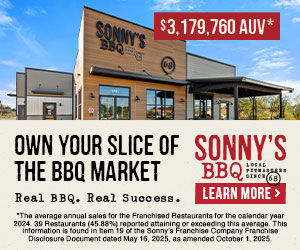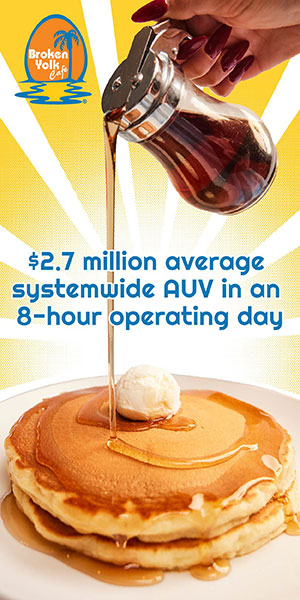Our next financial concept? OPM (other people's money). As a former commercial banker, I've had the opportunity to see both sides of the "debt/leverage" issue. When you go to a bank for a business loan, your banker (whether they tell you or not) will quickly compute your debt-to-equity ratio. As bankers, we viewed debt as an equivalent of risk: the higher your ratio, the more debt you have in proportion to equity. Therefore, the higher your financial risk. Let me explain why this is so. It all goes back to the financial basics: Assets = Liabilities + Net Worth.
- Steve LeFever
- 9,554 Reads 1 Shares
There's nothing more American than fast food restaurants - and some of them even serve apple pie! Fast food franchises have been meeting the growing needs of the country's on-the-go car culture and diverse life styles, complete with late-night hours and 24-hour service.
For decades, hamburgers, tacos, chicken, pizza, and subs were the mainstay of the fast food sector. In recent years, as customers began seeking healthier options, these standbys have been joined by wraps, smoothies, salads, frozen yogurt, and more. In 2010, one franchisor began offering vending machines containing fresh fruits and vegetables, protein drinks, and other health-oriented snacks.
- Eddy Goldberg
- 6,085 Reads 157 Shares
Jason Mann learned early that a career in advertising sales could get you just so far in life. And that wasn't far enough for him. So in 1999, at the age of 30, Mann stepped out of his sales role and joined forces with his father to enter the franchising business.
- John Carroll
- 4,210 Reads 11 Shares
The Financial Accounting Standards Board (FASB) and its international affiliate, the International Accounting Standards Board (IASB), are currently reviewing proposed new lease accounting rules that, if approved, will significantly affect the retail and restaurant industries.
- Dwayne Shackelford
- 11,398 Reads 1,151 Shares
Ask a group of multi-unit franchisees about the importance of customer service and you're likely to get a unanimous response. Strong customer service leads to positive operating results. However, creating a business environment that puts this customer service-focused strategy into action can be more difficult than it seems. The goal is to create a customer experience that brings loyal customers back again and again. One of the most knowledgeable experts on doing just this will be a featured speaker at this year's Multi-Unit Franchising Conference.
- Multi-Unit Franchisee
- 4,677 Reads 40 Shares
Just like in professional sports, a Most Valuable Player award is carefully and selectively bestowed on only a handful of the very best players. These players are unique and possess a drive to perform and win that goes beyond what most of their contemporaries can muster. This is the kind of individual selected annually for the Multi-Unit Franchisee Magazine MVP Awards.
- Multi-Unit Franchisee
- 6,268 Reads 57 Shares
Tom Kazbour doesn't believe the secret to success lies in studying the ABCs of business. He believes new franchisees can whiz on past most of the alphabet and focus on the letter "V."
- Debbie Selinsky
- 15,444 Reads 1 Shares
Franchisee validation can make or break your franchise sales. Pow! Just like that and a once-supercharged prospect can deflate to nothing in 24 hours, bailing out of your process instantly. Validation is the most influential stage in the selling process. What franchise owners say means far more than what corporate sales execs tell them. Franchise operators are "doing it," and it's their experiences that count foremost to cautious buyers.
- Steve Olson
- 5,527 Reads 110 Shares
As savvy franchise companies continue to flourish in a challenging economy, FUSR continues to bring you good news each month, highlighting brands that are adding units, increasing comp store sales, striking deals with investors, and continuing to grow. And, as the U.S. struggles through its "jobless recovery," growth-oriented franchisors continue to look overseas for expansion opportunities.
- Eddy Goldberg
- 10,477 Reads 93 Shares
I certainly enjoyed successful broker relationships over the past 20 years. Discovering qualified franchise owners through the professional efforts of franchise and business brokers contributed to the growth of several franchise companies I represented. Based on my personal experience and the insights from hundreds of franchisors who have sold broker-referred prospects, here's how to increase your popularity and closing rates with broker networks.
- Steve Olson
- 6,380 Reads 324 Shares
Have you been there? Where, you ask? On a ladder, climbing upward to obtain something, complete a task, or simply attempting to overcome an obstacle... like a wall.
- Larry Carnell
- 4,159 Reads 213 Shares
Last month we discussed the shift in online behavior and how it is affecting the way we engage with our prospects and customers. Social engagement is a concept and term we are growing comfortable with, but what is its real impact on growing a franchise business? More specifically, what is its direct impact on us as individuals in our specific roles in franchise growth and development?
- Tom Hochstatter
- 2,792 Reads 27 Shares
Multi-Unit Franchisee Magazine today announced the winners of the annual MVP (Most Valuable Player) Awards. These awards honor successful franchisees who have demonstrated outstanding performance in building their businesses, growing their brands, and serving their communities.
- PRESS RELEASE
- 5,475 Reads 12 Shares
In 2008 we dodged an international financial meltdown. In 2009 we saw the technical end of the second-longest-running recession in U.S. history. In 2010 we are wrapping up the first year of the recovery in a less-than-robust fashion. Let's look ahead to 2011 and what is in store for franchising and, in particular, access to capital.
- Darrell Johnson
- 5,036 Reads 1 Shares
Social network talk is often smothered with how many fans, friends, and followers you have. But what about helping your franchisees increase foot traffic to their businesses?
- Lisa Wehr
- 3,776 Reads 116 Shares
Multi-brand franchising allows multi-unit operators to balance risk and ride out the uncertainties of the marketplace in many ways...
- Multi-Unit Franchisee
- 5,653 Reads
Franchising continues to grow--not only in size, but in complexity--and in recent years, a huge part of that growth is attributable to multi-brand franchising.
- Multi-Unit Franchisee
- 6,453 Reads 212 Shares
With the stock market on a run at the start of 2011, I began thinking about the similarities of how stock investors and franchisees choose an investment. The obvious consideration in both cases is whether to make an investment, but that's just the starting point.
- Darrell Johnson
- 5,950 Reads 1 Shares
Franchisees are an optimistic lot, expansion-minded, on the grow, always alert to new opportunities. And for them, multi-unit franchising represents one of today's most attractive opportunities. Whether it involves increasing the number of units of their current brand or adding new brands to their holdings, the allure of multi-unit franchising is attracting the best and brightest franchisees in the business with increasing frequency.
- Multi-Unit Franchisee
- 5,082 Reads
Pierre Panos, a South African native of Greek descent, leaves little to chance. When the violence in his country became too dangerous in the early 1990s, Panos--a former Coopers & Lybrand accountant who'd followed his father into the restaurant and real estate industries--wanted to emigrate to a country where he and his family could be safe and settle for good.
- Debbie Selinsky
- 13,971 Reads 5 Shares
Multi-unit franchisees dominate today's marketplace, controlling more total units than their single-unit counterparts--and an increasing number are operating multiple brands.
- Kerry Pipes and Eddy Goldberg
- 4,837 Reads 21 Shares
Multi-unit franchising is one thing. Multi-concept franchising is something else entirely. Nevertheless, it's a place--and a choice--that many franchisees love, and where they excel. These determined operators look for growth opportunities and potential across several concepts, sometimes in wildly different sectors. The multi-concept franchising model offers power in numbers (units, brands, territory, and income potential), as well as the security of spreading their risk across different concepts in a diversified portfolio.
- Kerry Pipes
- 9,305 Reads 1,023 Shares
Do you do your utmost to be recognized as the best? Or do you strive to be average, ordinary, run-of-the-mill? While it's not what anyone is aiming for, mediocrity is commonplace--mediocre products, mediocre services, and mediocre customer service are the norm.
- Mel Kleiman
- 5,502 Reads
In a recent conversation with a franchisor, a comment was made that the area representative (AR) franchise expansion model is costly to implement and difficult to manage. When I asked a few questions seeking more specific details, I found that perceptions do not always reflect reality
- Marvin Storm
- 4,188 Reads 23 Shares
Franchise Update Media Group (FUMG), the leading industry resource for franchise development, announces that registration is now open for the First Annual Franchise Consumer Marketing Conference, to be held June 14-15 at the Omni San Francisco Hotel.
- PRESS RELEASE
- 2,651 Reads 1 Shares
Every business operation that's ever manufactured or sold a widget has relied on vendors. The people and companies that supply everything from paper and office supplies to mushrooms and cheese - and everything in between - are an integral part of a successful business operation.
- Kerry Pipes
- 25,268 Reads 3 Shares
The idea of operating a Taco Bell restaurant first came to Iris Cohn one evening in 1982.
That's when her husband, Dick, came home and told the family he wanted to open a Taco Bell in the Chicago area. So the couple took their daughter, Jennifer, to one of the restaurants, where they proceeded to order one of every item on the menu. "We were hooked," she recalls. Putting everything on the line, the Cohns became the first Taco Bell franchisees in the Chicago metro area, growing steadily over the years to become one of the brand's largest franchisees.
- Debbie Selinsky
- 5,838 Reads 55 Shares
In his book, Hire The American Dream, Dave Melton writes about his first boss, Frank Meeks. Melton writes of how Meeks was not only a personal inspiration but an icon within the community of Domino's Pizza. Meeks was the first franchisee inducted into the Domino's Chairman's Circle Hall of Fame.
- Multi-Unit Franchisee
- 7,145 Reads 1 Shares
What is Franchise Social Media? Basically, it's more than just social media. It's the application and utilization of social media within a franchise environment. Sure, many of the same principles apply. But, franchising is different than most small business models. It's unique in many ways beyond the typical B2B or B2C model. There are specific disclosure laws that are a major part of the franchise candidate recruitment process. Even from a consumer proposition standpoint, the integrity of the entire franchise organization must be considered. And, one cannot discuss social media in a franchise environment without touching upon guidelines, policies and procedures, and brand uniformity.
- Paul R Segreto
- 17,636 Reads 2 Shares
By now everyone is familiar with the Domino's Pizza "turnaround" campaign that's been all over the airwaves. The brand created a high profile marketing campaign that addressed negative consumer attitudes about its pizza by embracing the criticism and showing consumers that the brand was listening. The project has been an overwhelming success for the 9,000-store chain and president and CEO J. Patrick Doyle will offer an insider's look at the campaign from soup to nuts when he keynotes the 2011 Multi-Unit Franchising Conference in Las Vegas April 27-29.
- Multi-Unit Franchisee
- 5,647 Reads 8 Shares
| Page 238 of 278 | ^ Return to Top | Previous 236 237 238 239 240 Next |
| ADVERTISE | SPONSORED CONTENT |
FRANCHISE TOPICS
- Multi-Unit Franchising
- Get Started in Franchising
- Franchise Growth
- Franchise Operations
- Open New Units
- Franchise Leadership
- Franchise Marketing
- Technology
- Franchise Law
- Franchise Awards
- Franchise Rankings
- Franchise Trends
- Franchise Development
- Featured Franchise Stories
Subscribe
| ADVERTISE | SPONSORED CONTENT |




 The franchise opportunities listed above are not related to or endorsed by Franchising.com or Franchise Update Media Group. We are not engaged in, supporting, or endorsing any specific franchise, business opportunity, company or individual. No statement in this site is to be construed as a recommendation. We encourage prospective franchise buyers to perform extensive due diligence when considering a franchise opportunity.
The franchise opportunities listed above are not related to or endorsed by Franchising.com or Franchise Update Media Group. We are not engaged in, supporting, or endorsing any specific franchise, business opportunity, company or individual. No statement in this site is to be construed as a recommendation. We encourage prospective franchise buyers to perform extensive due diligence when considering a franchise opportunity.